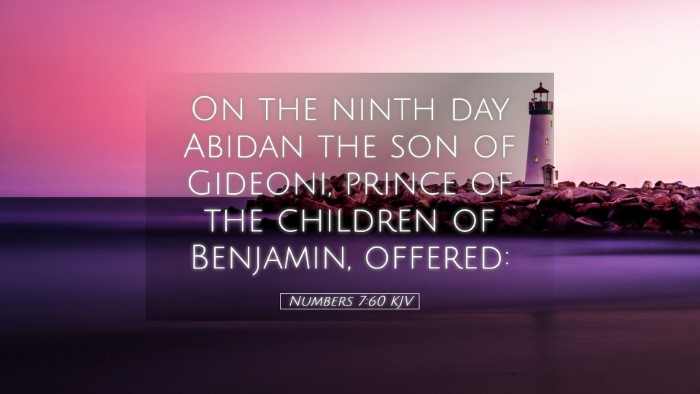Commentary on Numbers 7:60
The verse Numbers 7:60 states: “On the eighth day he offered his offering, which was one silver charger, the weight thereof was an hundred and thirty shekels, one silver bowl of seventy shekels, after the shekel of the sanctuary; both of them were full of fine flour mingled with oil for a meat offering.” This account belongs to a broader narrative where the leaders of the Israelites bring offerings to the tabernacle during the dedication of the altar.
Contextual Background
This verse is part of a detailed description of the offerings made by each of the twelve tribes of Israel. Each tribe's leader brought their gifts on consecutive days, culminating in the eighth day when the last leader brought forth his offerings. Understanding the weight and value of these offerings requires an appreciation of their symbolic significance in ancient Israelite worship.
Theological Significance
The offerings presented reflect a community's worship and dedication to God. In considering these contributions, scholars note the themes of sacrifice, communal identity, and the role of leadership in spiritual guidance.
1. Sacrifice and Devotion
Matthew Henry highlights the concept of sacrifice as central in the relationship between Israel and God. The act of offering precious metals and grains signifies a heartfelt devotion, where the people recognize God's provision and readiness to give back a portion for the work of the tabernacle and the service of the priests. The offerings also underscore the principle that true worship involves the giving of one's best to God.
2. Symbolism of the Offerings
Albert Barnes elaborates on the items presented: the silver charger and bowl are not merely physical objects but laden with meaning. The silver represents redemption (as it is often associated with purchasing back or atonement), and the flour mingled with oil symbolizes the richness of God's blessings, echoing the abundance of the promised land. Thus, these offerings can be seen as a reflection of the spiritual state of the nation.
3. Role of Leadership
Adam Clarke notes the significant role of the leaders in bringing forth these offerings. The actions of the tribal leaders serve as an example for the people, demonstrating accountability and the importance of collective worship. Their willingness to offer costly gifts for the altar reflects commitment not only to God but also to the spiritual well-being of the community.
Spiritual Application
The implications of this verse extend beyond historical analysis; it offers a template for contemporary worship and dedication. The nature of our offerings—whether material, spiritual, or relational—can serve as an indicator of our loyalty and love towards God. As pastors and theologians reflect on the text, they can encourage congregants to consider what they are willing to offer God in their own lives.
1. Assessing What We Offer
- Material Offerings: Consider the importance of prioritizing God in our financial stewardship and the giving of resources.
- Spiritual Offerings: Reflect on the call to offer our time, gifts, and service to the body of Christ.
- Relational Offerings: Encourage fostering relationships that build up and support worship and community.
2. Understanding Sacrifice
True sacrifice involves a sense of loss and cost. Just as the Israelites offered their best, believers today should thoughtfully consider their sacrifices. Is what we bring before God truly representative of our devotion?
3. Leading by Example
Leaders within the church must embody the principles illustrated in this verse. Their actions can inspire congregants to actively participate in worship and service. Pastors, in implementing these principles, become essential catalysts for eliciting a spirit of generosity and dedication among their members.
Conclusion
In conclusion, Numbers 7:60 serves as a vivid reminder of the Israelites' expressions of worship at the dedication of the altar, underscoring the profound importance of sacrifice, leadership, and community in their covenant relationship with God. By integrating the insights provided in this commentary, pastors, students, and scholars can deepen their understanding of worship and its implications for today's church.


